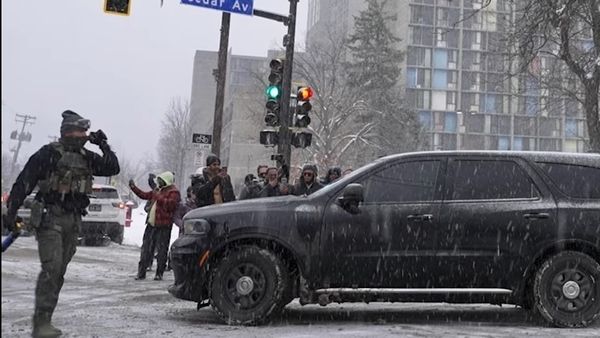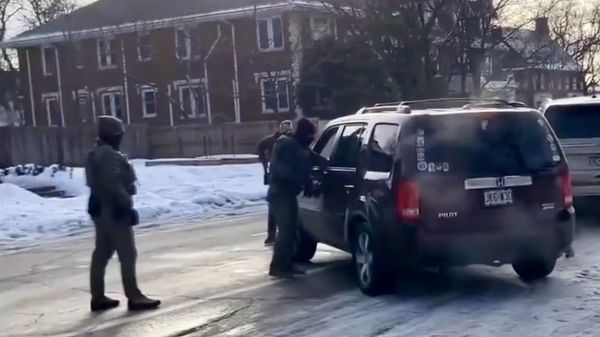On a September evening in Brisbane 60 years ago, a fire that would sound the death knell for the city's tram network was spreading through the Paddington Tram Depot.
The huge depot was propped up high above the city on the side of a hill on La Trobe Terrace, its tall timber supports overshadowing homes on both sides.
Inside, 65 trams — 20 per cent of the city's entire tram fleet — were parked.
On September 28, 1962, the 47-year-old timber and steel depot rapidly caught alight from end to end, fuelled by oil and grease stored underneath the building, and smouldered for days.
Trams burned to cinders, crashing through the heights of the depot to the ground below.
The Canberra Times reported that the only two workers in the depot managed to drive the three surviving trams clear, and salvage some cash, before the fierce heat took over.
"Five fire engines and four powerful pumps were used to fight the blaze, but lack of water pressure hampered firemen at first," The Times reported.
"Thousands of people jammed streets and vantage points around the depot and extra police had to be called to control them."
The cause of the fire was never established, but it became a turning point for the city's beloved tram network.
By the end of the night, only three trams had been saved, costing Brisbane City Council an estimated £500,000 — nearly $16 million in today's dollars.
The loss of 65 trams from the council's fleet of 375 put a huge strain on the public transport network.
In desperation, the council flew bus drivers down to Sydney to collect 15 borrowed buses to help fill the gaps.
Tram legacy
By the time of the fire, Brisbane's nearly 80-year-old tramways had gone through several iterations, from horse-drawn timber trams to fully electric open-door trolley cars.
The city's tram network grew rapidly in the 1920s and 30s until nearly 200 kilometres of track embedded in concrete sprawled across the suburbs.
Trams were popular in summer, with their original open design keeping passengers cool and four doors meaning they were quick to get in and out of.
Peak passenger numbers tipped 148 million trips in 1946 before competition from faster buses, the rise of private cars, and suburban shopping centres reducing travel into the CBD meant their role as Brisbane's primary mode of transport ended.
The Paddington fire renewed debate about their future, but vice-president of the Brisbane Tramway Museum Peter Hyde said trams "soldiered on" for another seven years after the blaze.
The council salvaged enough items from the fire to help build eight new trams to replace some of those lost.
The "Phoenix" trams were painted pale blue and bore the logo of the mythical bird, running until the tramway's closure in 1969.
Mr Hyde said one of the salvaged trams was still in operation at the Tramway Museum, a last legacy of Brisbane's tramway.
A love of cars
In 1962, the Canberra Times reported the cost of replacing the 65 burnt trams and the Paddington depot was estimated to be £2 million pounds — $63 million in today's dollars.
"Brisbane tram passengers have the doubtful pleasure of watching buses bound for neighbouring suburbs whizz past the trams to provide a faster service," the Canberra Times correspondent reported weeks later.
The reporter added that while Sydney and Adelaide had already moved to buses, Brisbane clung to "an inordinate love of trams".
By the time Clem Jones became Brisbane's lord mayor in 1961, political favour had turned away from the slow electric trams to faster, more modern buses.
And Brisbane's love for trams was not enough to save them, as Mr Jones ordered a city-wide transport study from American traffic engineering company Wilbur Smith and Associates.
The Wilber Smith report recommended buses replace trams, laid the grounds for the Riverside Expressway and Brisbane's network of freeways, and led to decades of car-focused planning.
"The main contributing factor, of course, was Clem Jones ... who was a very passionate advocate for motor vehicles and being able to drive from your home to your office," Mr Hyde said.
Mr Jones was quoted as saying the council was "trying to get rid of public transport" as the city focused on motor cars. The council's move to scrap trams was unpopular with the community, but the council held fast.
And on August 13, 1969, the Canberra Times reported the end of Brisbane's trams.
"Late tomorrow night, Brisbane's last tram will make its last journey," the Times reported.
"It will swing off the street and slide to a stop in a depot yard, and by Monday morning an era will have ended."
The Brisbane Tramway Museum will hold a gala day on Saturday, September 24, marking the 60th anniversary of the Paddington Depot fire.







